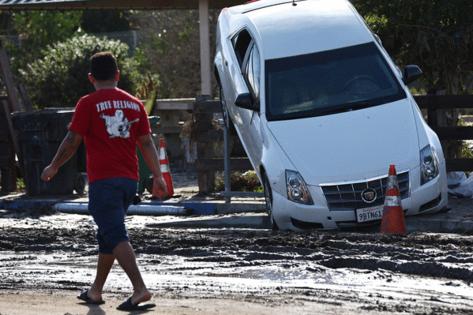'This is too much': An unknown number of San Diego's flood victims are still homeless
Published in News & Features
Seven months after thousands of families were displaced by historic floods, some are back home. Others have become homeless. And nobody’s quite sure how many.
City agencies and community organizations have tried to ensure every family is accounted for. But many are certain that hundreds of families have fallen through the cracks.
“There’s a lot of legwork that has to be done to case-manage each individual situation,” said Azucena Valladolid, the San Diego Housing Commission’s executive vice president of rental assistance and workforce development. “These families have a variety of barriers that are making it extremely challenging to secure housing.”
Some of those left homeless by the floods are living on the streets. Others are couch-surfing.
And then there are those who never left their destroyed homes. Many people are still living in gutted homes, surrounded by construction or mold, simply because they couldn’t find anywhere else to go.
A total of 2,400 households — nearly all in communities where flood insurance coverage is low — were impacted by the floods. Nearly 8,000 people were affected, and thousands displaced.
At its peak in March, the county was sheltering 2,600 people across 68 hotels through its temporary lodging program. Even when it ended in June, more than 300 households were still participating.
But it’s unclear what has happened to all of them since. Government agencies aren’t tracking that data. Homeless services providers may not be, either — most generally do not ask such specific intake questions and rely only on voluntarily shared information.
Of those more than 300 families that were still counting on county housing support when the program ended, most were from the city of San Diego.
The San Diego Housing Commission managed to connect successfully with 204 of them, and 50 of those were referred to shelters.
San Diego’s homeless service providers say they have not seen an uptick in requests for service since the floods, and that the number of people requesting shelter has remained consistent across them.
Paula Silva considers her family lucky. All six have been staying at a family shelter in Barrio Logan for nearly two months, and they’re still hoping to return to their old apartment once their landlord finishes rebuilding.
Those same hopes are dwindling for Jessica, who asked to be identified by only her first name.
After the county’s hotel voucher program ended, she and her husband were desperate to find somewhere to wait things out. They’re now sharing one very small bedroom in her father’s house and bought a mattress for their three kids — who range in age from 4 to 18 — while they sleep on the floor.
“We had plans for the future, to get something bigger or buy a house,” she said, tearing up. “To now be living like we are — this is too much.”
Her landlord has refused to cooperate with the housing commission, leaving her ineligible for housing commission rental assistance. Instead, the commission has created a new option: a lump-sum payment — less money than she would get in monthly rental aid with a traditional lease — but they have yet to receive the funds.
“They don’t answer my calls,” Jessica said. “I was crying, asking them, ‘Where is the help that you promised me?’”
After Karina Escalante’s landlord told her he intended to rent her apartment to someone else who’d pay more, she had no choice but to search for an alternative.
She and her 12-year-old son lived in their car for about a week, but with an existing neck injury, the pain was too much for her — she’s now scheduled for surgery later this month.
“So many people are on the street and are becoming homeless, so I got an apartment while I could,” Escalante said.
She’s now paying $2,700 for a small apartment, which is more than $1,000 more than what she had been paying — and way more than she can afford.
“It’s too much,” she said in Spanish. “I don’t know what I’m going to do, to tell you the truth.”
Just after the floods, the housing commission acknowledged that victims’ lives could be disrupted for as long as a year. On Feb. 16, at their first meeting after the storm, Chair Mitch Mitchell called for agencies to work together, calling it “a time for collaboration and creativity, not consternation.”
Vice Chair Ryan Clumpner got emotional at that meeting, blaming “targeted underinvestment” in some of the communities hit hardest.
And displaced families wouldn’t be the only victims, he said, as redirecting resources would only take from the limited services available for another of San Diego’s most vulnerable populations — people who are already homeless.
“That is the absolute worst possible way I can imagine to handle disaster response — a disaster response that was predictable,” Clumpner said. “People talked about the need to prevent and to address and to invest more equitably. And here we are, cleaning up the mess, using funds that should never have to be used for this purpose, but they’re the only things that are available.”
About 50 employees of the commission’s homeless housing innovations division pivoted to help flood victims, President and CEO Lisa Jones said at the time. “We’ve had to leverage our staff to work in other areas,” Valladolid added.
In the months that followed, commissioners kept reiterating similar concerns.
But that has not helped displaced people like Karla Gomez who still haven’t found homes or gotten off shelter waitlists.
She and her 14-year-old son were living in a tent for a few weeks, before moving into a small bedroom they rented. But they only have until Thursday before they have to find a new place to live.
But she’s more worried about her 18-year-old son, who went to live with his father in Tijuana after the floods — which ended up worse for him than homelessness.
“You know what life is like there,” she said in Spanish. “He fell into drugs and needs help.”
_____
©2024 The San Diego Union-Tribune. Visit sandiegouniontribune.com. Distributed by Tribune Content Agency, LLC.







Comments